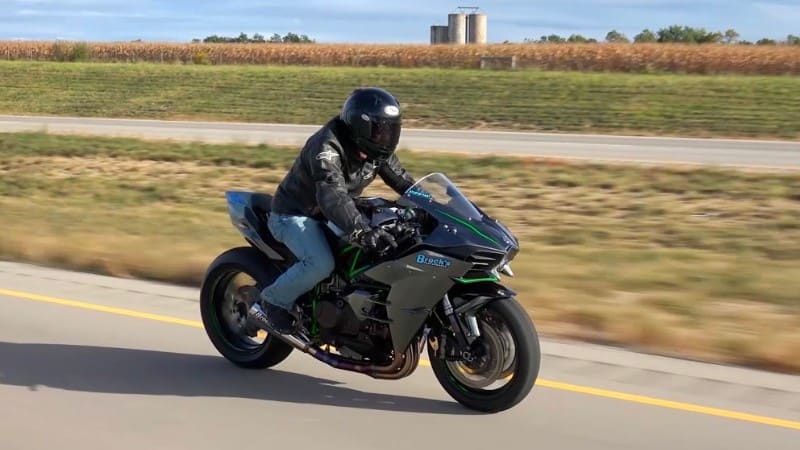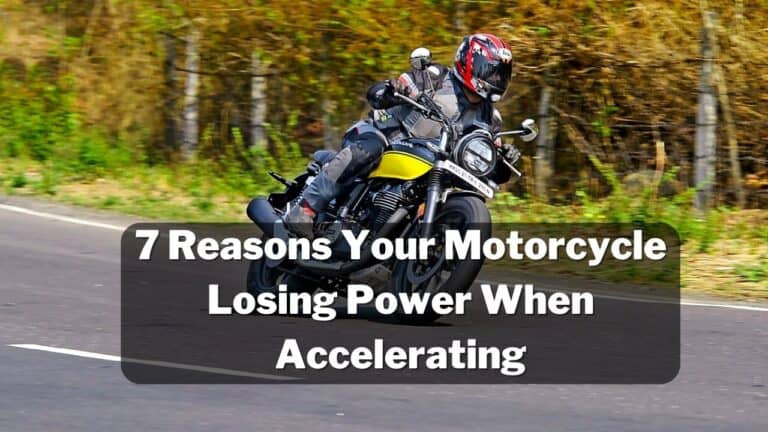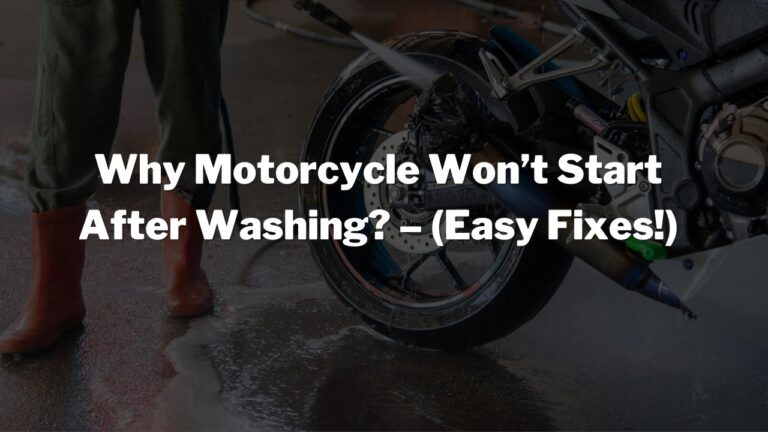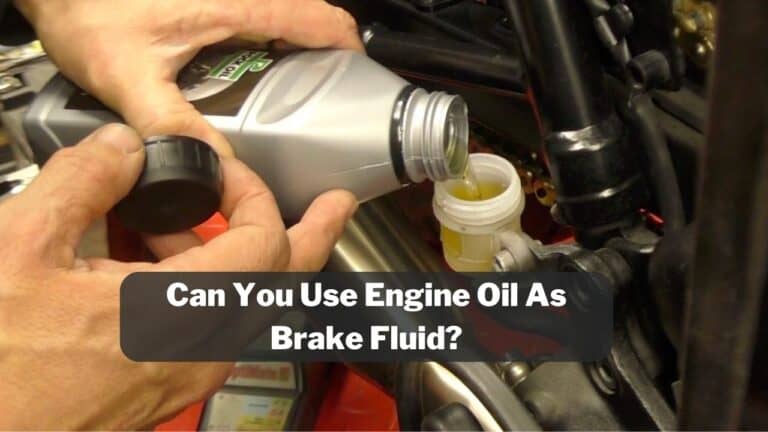How Fast Can A Motorcycle Go? – (Top Speed Chart)
A few days back, I received an email about motorcycle top speed. As a motorcycle enthusiast with an engineering background, I know the various factors that make a motorcycle faster than a car. In fact, Kawasaki Ninja H2R has defeated an F1 racing car in a drag race (video embedded below).
So, how fast can a motorcycle go? A hyperbike (Kawasaki Ninja H2R) can reach a speed of 249 miles per hour, but it’s not street-legal. The fastest street-legal motorcycle is Kawasaki Ninja ZX-14R, which can go up to 240 miles per hour. However, an average motorcycle can go as fast as 80 to 165 mph.
In this guide, we’ll see how fast a motorcycle can go and what factors affect the top speed of a motorcycle.
The average top speed of motorcycles is as follows–
- 125cc motorcycles: 60 to 75 mph
- 250cc motorcycles: 80 to 110 mph
- 500cc motorcycles: 90 to 120 mph
- 600cc motorcycles: 90 to 165 mph
- 1000cc motorcycles: 100 to 186 mph
Table of Contents
- 1 What Makes Motorcycles Accelerate So Fast
- 2 What Factors Affect Motorcycle Speed
- 3 Motorcycle Top Speed Chart (By Engine Size)
- 4 World’s Fastest Street Legal Motorcycles (Top Speed Chart)
- 5 How Fast Do Professional Motorcycle Riders Go?
- 6 Can A Motorcycle Go 300 MPH?
- 7 Can A Motorcycle Hit 250 MPH?
- 8 How Fast Is A 1000cc Bike?
- 9 What Motorcycle Can Hit 180 MPH?
- 10 Conclusion
What Makes Motorcycles Accelerate So Fast

Two main reasons a motorcycle runs faster than cars are the Power Weight Ratio (PWR) and Aerodynamics. The motorcycle with a 1000cc engine size can defeat a car with a 2500cc engine. It’s because motorcycles are lightweight and have good aerodynamics.
Modern motorcycles come with a Traction Control System that increases initial acceleration. Traction Control reads the speed of a motorcycle’s front and rear wheels and synchronizes the power output to accelerate faster.
1. Power To Weight Ratio
The power-to-weight ratio (PWR) measures the actual performance of any engine or power source. The formula to calculate the power-to-weight ratio of any vehicle is as follows-
PWR= Power Output/Vehicle’s Weight
So, a car engine produces more power, but due to its heavy weight, some power is consumed to pull the car’s weight, while motorcycles are lightweight and run faster.
2. Aerodynamics
The shape and size of a vehicle also affect its top speed. While riding any vehicle, the air applies drag force in the opposite direction and tries to stop the vehicle. The intensity of air drag increases with speed. That’s why F1 racing cars are designed aerodynamically.
All modern superbikes are designed aerodynamically, which minimizes air drag at higher speeds. That’s why motorcycles accelerate so fast and can outrace many cars.
What Factors Affect Motorcycle Speed
If participating in any drag race, you must know all the major factors affecting the motorcycle’s speed. As a mechanical engineer, I know about automobile engines and other factors affecting performance.
Here are some factors that affect the motorcycle’s speed-
1. Engine Size
The engine size is an important factor that affects motorcycle speed. The large engine size (measured in cubic centimeters) produces more power, pushing the bike faster. A 125cc motorcycle can not defeat a 250cc motorcycle.
It’s a common thing that everybody knows. But you must have seen that a motorcycle of the same engine size produces different horsepower.
This is because of the stroke length. An engine with a smaller stroke length will produce more power (of the same cubic centimeters) because the connecting rod travels less distance.
2. Aerodynamics
When we ride a motorcycle at a higher speed, the air applies backward force and tries to stop the motorcycle.
If a motorcycle is aerodynamically designed, the impact of air drag will be minimal, increasing its top speed.
That’s why an aerodynamically designed motorcycle runs faster and conveniently maneuvers at higher speeds.
3. Motorcycle Weight
The power produced by a motorcycle engine is fixed. If the motorcycle’s weight increases (if you add additional accessories), it will drop the top speed. It’s because some power will be consumed in carrying that extra load.
That’s why lightweight sportbikes run faster than cruiser motorcycles. Because cruiser motorcycles are heavy, a lot of engine power is consumed in carrying that weight.
4. Rider Weight
The weight of the rider also affects the top speed of a motorcycle. It’s because some power produced by the motorcycle engines goes into carrying the rider’s weight. Hence, a lightweight motorcyclist can accelerate the motorcycle faster than a heavyweight rider.
5. Tire Pressure
It is a lesser-known fact that tire pressure also affects a motorcycle’s top speed. If a motorcycle’s tire has less pressure, it will increase the surface contact, which applies more frictional force, and try to stop the vehicle every second.
So, ensure your motorcycle has sufficient tire pressure before participating in any drag race. The motorcycle manufacturers recommend tire pressure of 2.5 Kgf/cm2 for the front wheel and 2.9 Kgf/cm2 for the rear.
6. Weather Condition
Weather conditions also affect the motorcycle’s top speed. When riding a motorcycle, the rider and the motorcycle create a significant amount of aerodynamic drag as they move through the air. This drag increases with the speed of the motorcycle.
When riding into a headwind, the wind creates additional aerodynamic drag, making it more difficult for the motorcycle to maintain its top speed.
Motorcycle Top Speed Chart (By Engine Size)
As you’ve seen, the top speed of a motorcycle depends upon various factors. However, I have still prepared the average numbers into one motorcycle top speed chart.
| Engine Size (cc) | Top Speed (mph) |
|---|---|
| 50cc | 30-50 |
| 100cc | 45-65 |
| 125cc | 60-75 |
| 150cc | 65-80 |
| 200cc | 65-90 |
| 250cc | 80-110 |
| 300cc | 90-115 |
| 350cc | 90-120 |
| 500cc | 95-130 |
| 600cc | 95-165 |
| 750cc | 100-170 |
| 800cc | 100-180 |
| 900cc | 100-186 |
| 1000cc | 100-186 |
| 1100cc | 120-190 |
| 1200cc | 120-200 |
| 1300cc | 130-210 |
| 1500cc | 130-215 |
| 2000cc | 150-220 |
World’s Fastest Street Legal Motorcycles (Top Speed Chart)
Kawasaki Ninja H2R is the world’s fastest motorcycle produced by Kawasaki that has recorded the highest speed of 249 miles per hour (400 Km/hr). However, this motorcycle is not street-legal.
I have prepared the world’s fastest street-legal motorcycle chart. I hope you’ll like it.
| Motorcycle | Top Speed (mph) |
|---|---|
| Kawasaki Ninja ZX-14R | 240 mph |
| Ducati Superleggera V4 | 202 mph |
| Ducati 1199 Panigale R | 200 mph |
| Suzuki GSX1300 R Hayabusa | 194 mph |
| Aprilia RSV4 1100 Factory | 190 mph |
How Fast Do Professional Motorcycle Riders Go?
The professional motorcycle riders in F1 racing and MotoGP go at 221.5 mph. However, this speed is not safe for highway rides. Motorcycle riders on interstate highways go anywhere between 170 to 190 miles per hour.
Can A Motorcycle Go 300 MPH?
The world’s fastest motorcycle, Kawasaki Ninja H2R, has recorded the highest speed of 249 miles per hour. However, that motorcycle is not street-legal. But Bill Warner has reached 300 mph on a Suzuki Hayabusa-based motorcycle in Maine (report).
Can A Motorcycle Hit 250 MPH?
Yes, a motorcycle can hit 250 mph at top speed. Kawasaki Ninja H2R has reached 249 mph top speed on a closed public road. But it’s not advisable to ride at such high speeds on highways.
How Fast Is A 1000cc Bike?
As I mentioned earlier, the top speed of a motorcycle depends upon various factors. However, the average top speed of a 1000cc motorcycle varies between 100 to 189 miles per hour. But Kawasaki Ninja H2R with a 998cc engine recorded a top speed of 249 miles per hour on a closed public road.
What Motorcycle Can Hit 180 MPH?
The hyperbike can easily hit 180 miles per hour with a high power-to-weight ratio and aerodynamics. I have listed some motorcycles that can hit 180 mph.
- Kawasaki Ninja ZR-14R: 240 MPH
- Ducati Superleggera V4: 202 MPH
- Ducati 1199 Panigale R: 200 MPH
- Suzuki GSX1300 R Hayabusa: 194 MPH
- Aprilia RSV4 1100 Factory: 190 MPH
- BMW S1000RR: 188 MPH
- Honda RBR1000RR-R Fireblade: 186 MPH
- Yamaha YZF R1: 185 MPH
Conclusion
The fastest motorcycle, Kawasaki Ninja H2R, has recorded a top speed of 249 mph on a closed public road. However, some riders have reached over 300 mph milestone of the Suzuki Hayabusa-based motorcycle. I hope you enjoyed reading this article. Please share your feedback in the comment box.






Thank you for no ads..orcat least i didnt notice any.